目录
-
- 一、函数
-
- 1.1 常用函数
-
- 1.1.1 导⼊数据
- 1.1.2 导出数据
- 1.1.3 查看数据
- 1.1.4 数据选取
- 1.1.5 数据处理
- 1.1.6 数据分组和排序
- 1.1.7 数据合并
- 1.1.8 数据显示
- 1.2 函数列表
-
- 1.2.1 统计汇总函数
- 1.2.2 数据清洗函数
- 1.2.3 数据筛选函数
- 1.2.4 绘图与元素级运算函数
- 1.2.5 时间序列函数
- 1.2.6 其他函数
- 二、75个高频操作
-
- 目录
- 2.1、pandas导入、查看版本
- 2.2、使用python list、python dict、numpy.ndarray创建pandas.Series
- 2.3、将pandas.Series转化为pandas.DataFrame
- 2.4、将多个pandas.Series合并为一个pandas.DataFrame
- 2.5、修改pandas.Series index名称
- 2.6、pandas.Series1移除pandas.Series1中和pandas.Series2共同的部分
- 2.7、求pandas.Series1和pandas.Series2的交集、并集、差集
- 2.8、求pandas.Series分位数(最小值、1/4分位数、中位数、3/4分位数、最大值)
- 2.9、求pandas.Series()频数
- 2.10、输出pandas.Series()中频数排第一二位的、其它的替换为other
- 2.11、将pandas.Series()均分为10个区间、每个值使用区间名称标记
- 2.12、将pandas.Series()转换为指定shape的pandas.DataFrame
- 2.13、取出pandas.Series()中满足条件数据的位置index
- 2.14、取出pandas.Series()指定位置的数据
- 2.15、pandas.Series()水平、垂直合并
- 2.16、输出pandas.Series()子集的index号
- 2.17、求真实和预测pd.Series之间的均方误差损失函数(MSE,mean squared error)
- 2.18、pd.Series字符串型数据首字母大写转换
- 2.19、pd.Series字符串型数据字符长度计算
- 2.20、pd.Series中两两数之间差异
- 2.21、pd.Series中日期字符串转换为datetime格式
- 2.22、获取pd.Series日期字符串中时间对象
- 2.23、pd.Series日期字符串中修改为按指定日期输出
- 2.24、输出pd.Series中至少包含两个元音字符的数据
- 2.25、输出pd.Series中有效的email地址
- 2.26、pd.Series1按pd.Series2分组并求均值
- 2.27、计算两个pd.Series之间的欧式距离
- 2.28、求pd.Series局部峰值index
- 2.29、pd.Series字符串数据中使用最低频字符填充空格
- 2.30、创建时间序列数据,赋予随机值
- 2.31、缺省的时间序列值 不同方式填充
- 2.32、找出pd.Series中自相关性最大的数据
- 2.33、从一个csv 文件中每间隔50行取数据生成pandas.DataFrame
- 2.34、从一个csv 文件取数据生成pandas.DataFrame(新增加一分类列)
- 2.35、生成一个按规定步长平移的pandas.DataFrame
- 2.36、从一个csv 文件读取指定列生成pandas.DataFrame
- 2.37、输出DataFrame的行数、列数、数据类型、类型频数、Series转list
- 2.38、输出满足某个规则的DataFrame数据行和列号
- 2.39、修改DataFrame的列名称
- 2.40、DataFrame中是否有缺省值确认
- 2.41、DataFrame中缺省值统计
- 2.42、各自列均值填充DataFrame中各自列缺省值
- 2.43、各自列均值、中值填充DataFrame中各自列缺省值(使用apply)
- 2.44、从DataFrame选择子DataFrame
- 2.45、 改变DataFrame列顺序
- 2.46、大DataFrame修改默认显示的行和列数
- 2.47、DataFrame数据小数位数设置
- 2.48、 DataFrame数据小数转百分比显示
- 2.49、DataFrame数据每隔20行读取
- 2.50、创建DataFrame主键
- 2.51、获取DataFrame某一列中第n大的值索引
- 2.52、获取DataFrame某一列中第n大的值大于指定值得索引
- 2.53、获取DataFrame中行和大于100的行
- 2.54、 Series or DataFrame中使用分位数填充超限区域
- 2.55、去除指定值将DataFrame转换为最大方阵
- 2.56、DataFrame两行交换
- 2.57、DataFrame逆序输出
- 2.58、DataFrame转对角矩阵
- 2.59、DataFrame那一列含有最多行最大值
- 2.60、DataFrame创建新列:每行为行号(按欧几里得距离而来)
- 2.61、求DataFrame各列之间最大相关系数
- 2.62、DataFrame创建一列:包含每行中最小值与最大值比值
- 2.63、DataFrame创建一列:包含每行中第二大的值
- 2.64、DataFrame每列按特定方式归一化
- 2.65、计算DataFrame每行与后一行的相关系数
- 2.66、DataFrame对角线元素替换为0
- 2.67、DataFrame按某列分组、提取某个分组
- 2.68、DataFrame按另外列分组、提取当前列中指定值(看下方例子,需求不好描述)
- 2.69、DataFrame分组(看下方例子,需求不好描述)
- 2.70、两个DataFrame使用类似SQL 中INNER JOIN拼接
- 2.71、移除DataFrame1中在DataFrame2出现的行
- 2.72、取出DataFrame中两列值相等的行号
- 2.73、DataFrame中新建两列:滞后列和提前列(看下方例子,需求BT)
- 2.74、DataFrame中所有值出现频次统计
- 2.75、拆分DataFrame中某列文本为两列
- 2.100 代码块
一、函数
1.1 常用函数
1.1.1 导⼊数据
pd.DataFrame()
pd.read_csv(filename)
pd.read_table(filename)
pd.read_excel(filename)
pd.read_sql(query,connection_object)
pd.read_json(json_string)
pd.read_html(url)
1.1.2 导出数据
df.to_csv(filename)
df.to_excel(filename)
df.to_sql(table_name,connection_object)
df.to_json(filename)
writer=pd.ExcelWriter('test.xlsx',index=False)
df1.to_excel(writer,sheet_name='单位')和writer.save(),将多个数据帧写⼊同⼀个⼯作簿的多个sheet(⼯作表)
1.1.3 查看数据
df.head(n)
df.tail(n)
df.shape()
df.info()
df.columns()
df.describe()
s.value_counts(dropna=False)
df.apply(pd.Series.value_counts)
df.isnull().any()
df[df[column_name].duplicated()]
df[df[column_name].duplicated()].count()
1.1.4 数据选取
df[col]
df[[col1,col2]]
s.iloc[0]
s.loc['index_one']
df.iloc[0,:]
df.iloc[0,0]
df.loc[0,:]
df.ix[[:5],["col1","col2"]]
iloc的结合体。
df.at[5,"col1"]
df.iat[5,0]
1.1.5 数据处理
df.columns= ['a','b','c']
pd.isnull()
pd.notnull()
df.dropna()
df.dropna(axis=1)
df.dropna(axis=1,thresh=n)
df.fillna(value=x)
df[column_name].fillna(x)
s.astype(float)
s.replace(1,'one')
s.replace([1,3],['one','three'])
df.rename(columns=lambdax:x+1)
df.rename(columns={
'old_name':'new_ name'})
df.set_index('column_one')
df.reset_index("col1")
df.rename(index=lambdax:x+1)
1.1.6 数据分组和排序
df.sort_index().loc[:5]
df.sort_values(col1)
df.sort_values(col2,ascending=False)
df.sort_values([col1,col2],ascending=[True,False])
df.groupby(col)
df.groupby([col1,col2])
df.groupby(col1)[col2].agg(mean)
df.pivot_table(index=col1,values=[col2,col3],aggfunc={
col2:max,col3:[ma,min]})
df.groupby(col1).agg(np.mean)
df.groupby(col1).col2.agg(['min','max'])
data.apply(np.mean)
data.apply(np.max,axis=1)
df.groupby(col1).col2.transform("sum")
1.1.7 数据合并
df1.append(df2)
df.concat([df1,df2],axis=1,join='inner')
df1.join(df2.set_index(col1),on=col1,how='inner')
pd.merge(df1,df2,on='col1',how='outer')
pd.merge(df1,df2,left_index=True,right_index=True,how='outer')
1.1.8 数据显示
pd.set_option('display.max_rows', None)
pd.set_option('display.max_columns', None)
pd.set_option('max_colwidth', None)
pd.set_option('expand_frame_repr',True)
pd.set_option('display.width', 80)
1.2 函数列表
整理了100个Pandas常用的函数,分别分为6类:统计汇总函数、数据清洗函数、数据筛选函数、绘图与元素级运算函数、时间序列函数和其他函数。
1.2.1 统计汇总函数
| 函数名 |
功能 |
参数及说明 |
| min() |
计算最小值 |
|
| max() |
计算最大值 |
|
| sum() |
求和 |
|
| mean() |
计算平均值 |
|
| count() |
计数(统计非缺失元素的个数) |
|
| size() |
计数(统计所有元素的个数) |
|
| median() |
计算中位数 |
|
| var() |
计算方差 |
|
| std() |
计算标准差 |
|
| quantile() |
计算任意分位数 |
|
| cov() |
计算协方差 |
|
| corr() |
计算相关系数 |
|
| skew() |
计算偏度 |
|
| kurt() |
计算峰度 |
|
| mode() |
计算众数 |
|
| describe() |
描述性统计(一次性返回多个统计结果) |
|
| groupby() |
分组 |
|
| aggregate() |
聚合运算(可以自定义统计函数) |
|
| argmin() |
寻找最小值所在位置 |
|
| argmax() |
寻找最大值所在位置 |
|
| any() |
等价于逻辑“或” |
|
| all() |
等价于逻辑“与” |
|
| value_counts() |
频次统计 |
|
| cumsum() |
运算累计和 |
|
| cumprod() |
运算累计积 |
|
| pct_change() |
运算比率(后一个元素与前一个元素的比率) |
|
1.2.2 数据清洗函数
| 函数名 |
功能 |
参数及说明 |
| duplicated() |
判断序列元素是否重复 |
|
| drop_duplicates() |
删除重复值 |
|
| hasnans() |
判断序列是否存在缺失(返回TRUE或FALSE) |
|
| isnull() |
判断序列元素是否为缺失(返回与序列长度一样的bool值) |
|
| notnull() |
判断序列元素是否不为缺失(返回与序列长度一样的bool值) |
|
| dropna() |
删除缺失值 |
|
| fillna() |
缺失值填充 |
|
| ffill() |
前向后填充缺失值(使用缺失值的前一个元素填充) |
|
| bfill() |
后向填充缺失值(使用缺失值的后一个元素填充) |
|
| dtypes() |
检查数据类型 |
|
| astype() |
类型强制转换 |
|
| pd.to_datetime |
转日期时间型 |
|
| factorize() |
因子化转换 |
|
| sample() |
抽样 |
|
| where() |
基于条件判断的值替换 |
|
| replace() |
按值替换(不可使用正则) |
|
| str.replace() |
按值替换(可使用正则) |
|
| str.split.str() |
字符分隔 |
|
1.2.3 数据筛选函数
| 函数名 |
功能 |
参数及说明 |
| isin() |
成员关系判断 |
|
| between() |
区间判断 |
|
| loc() |
条件判断(可使用在数据框中) |
|
| iloc() |
索引判断(可使用在数据框中) |
|
| compress() |
条件判断 |
|
| nlargest() |
搜寻最大的n个元素 |
|
| nsmallest() |
搜寻最小的n个元素 |
|
| str.findall() |
子串查询(可使用正则) |
|
| query |
查询函数 |
格式:df.query(‘expression’)。示例:df.query(“brand in [‘Python数据之道’,‘价值前瞻’,‘菜鸟数据之道’] & A > 3 & B > 3”) 等同于:df[(df[‘brand’].isin([‘Python数据之道’,‘价值前瞻’,‘菜鸟数据之道’])) & (df[‘A’] > 3) & (df[‘B’] > 3)] |
import pandas as pd
df = pd.DataFrame({
'brand':['Python数据之道','价值前瞻','菜鸟数据之道','Python','Java'],
'A':[10,2,5,20,16],
'B':[4,6,8,12,10],
'C':[8,12,18,8,2],
'D':[6,18,14,6,12],
'till years':[4,1,1,30,30]})
df.query("brand in ['Python数据之道','价值前瞻','菜鸟数据之道'] & A > 3 & B > 3")
df[(df['brand'].isin(['Python数据之道','价值前瞻','菜鸟数据之道'])) & (df['A'] > 3) & (df['B'] > 3)]

1.2.4 绘图与元素级运算函数
| 函数名 |
功能 |
参数及说明 |
| hist() |
绘制直方图 |
|
| plot() |
可基于kind参数绘制更多图形(饼图,折线图,箱线图等) |
|
| map() |
元素映射 |
|
| apply() |
基于自定义函数的元素级操作 |
|
1.2.5 时间序列函数
| 函数名 |
功能 |
参数及说明 |
| dt.date() |
抽取出日期值 |
|
| dt.time() |
抽取出时间(时分秒) |
|
| dt.year() |
抽取出年 |
|
| dt.mouth() |
抽取出月 |
|
| dt.day() |
抽取出日 |
|
| dt.hour() |
抽取出时 |
|
| dt.minute() |
抽取出分钟 |
|
| dt.second() |
抽取出秒 |
|
| dt.quarter() |
抽取出季度 |
|
| dt.weekday() |
抽取出星期几(返回数值型) |
|
| dt.weekday_name() |
抽取出星期几(返回字符型) |
|
| dt.week() |
抽取出年中的第几周 |
|
| dt.dayofyear() |
抽取出年中的第几天 |
|
| dt.daysinmonth() |
抽取出月对应的最大天数 |
|
| dt.is_month_start() |
判断日期是否为当月的第一天 |
|
| dt.is_month_end() |
判断日期是否为当月的最后一天 |
|
| dt.is_quarter_start() |
判断日期是否为当季度的第一天 |
|
| dt.is_quarter_end() |
判断日期是否为当季度的最后一天 |
|
| dt.is_year_start() |
判断日期是否为当年的第一天 |
|
| dt.is_year_end() |
判断日期是否为当年的最后一天 |
|
| dt.is_leap_year() |
判断日期是否为闰年 |
|
1.2.6 其他函数
| 函数名 |
功能 |
参数及说明 |
| append() |
序列元素的追加(需指定其他序列) |
|
| diff() |
一阶差分 |
|
| round() |
元素的四舍五入 |
|
| sort_values() |
按值排序 |
|
| sort_index() |
按索引排序 |
|
| to_dict() |
转为字典 |
|
| tolist() |
转为列表 |
|
| unique() |
元素排重 |
|
二、75个高频操作
目录
1、pandas导入、查看版本
2、使用python list、python dict、numpy.ndarray创建pandas.Series
3、将pandas.Series转化为pandas.DataFrame
4、将多个pandas.Series合并为一个pandas.DataFrame
5、修改pandas.Series index名称
6、pandas.Series1移除pandas.Series1中和pandas.Series2共同的部分
7、求pandas.Series1和pandas.Series2的交集、并集、差集
8、求pandas.Series分位数(最小值、1/4分位数、中位数、3/4分位数、最大值)
9、求pandas.Series()频数
10、输出pandas.Series()中频数排第一二位的、其它的替换为other
11、将pandas.Series()均分为10个区间、每个值使用区间名称标记
12、将pandas.Series()转换为指定shape的pandas.DataFrame
13、取出pandas.Series()中满足条件数据的位置index
14、取出pandas.Series()指定位置的数据
15、pandas.Series()水平、垂直合并
16、输出pandas.Series()子集的index号
17、求真实和预测pd.Series之间的均方误差损失函数(MSE,mean squared error)
18、pd.Series字符串型数据首字母大写转换
19、pd.Series字符串型数据字符长度计算
20、pd.Series中两两数之间差异
21、pd.Series中日期字符串转换为datetime格式
22、获取pd.Series日期字符串中时间对象
23、pd.Series日期字符串中修改为按指定日期输出
24、输出pd.Series中至少包含两个元音字符的数据
25、输出pd.Series中有效的email地址
26、pd.Series1按pd.Series2分组并求均值
27、计算两个pd.Series之间的欧式距离
28、求pd.Series局部峰值index
29、pd.Series字符串数据中使用最低频字符填充空格
30、创建时间序列数据,赋予随机值
31、缺省的时间序列值 不同方式填充
32、找出pd.Series中自相关性最大的数据
33、从一个csv 文件中每间隔50行取数据生成pandas.DataFrame
34、从一个csv 文件取数据生成pandas.DataFrame(新增加一分类列)
35、生成一个按规定步长平移的pandas.DataFrame
36、从一个csv 文件读取指定列生成pandas.DataFrame
37、输出DataFrame的行数、列数、数据类型、类型频数、Series转list
38、输出满足某个规则的DataFrame数据行和列号
39、修改DataFrame的列名称
40、DataFrame中是否有缺省值确认
41、DataFrame中缺省值统计
42、各自列均值填充DataFrame中各自列缺省值
43、各自列均值、中值填充DataFrame中各自列缺省值(使用apply)
44、从DataFrame选择子DataFrame
45、 改变DataFrame列顺序
46、大DataFrame修改默认显示的行和列数
47、DataFrame数据小数位数设置
48、 DataFrame数据小数转百分比显示
49、DataFrame数据每隔20行读取
50、创建DataFrame主键
51、获取DataFrame某一列中第n大的值索引
52、获取DataFrame某一列中第n大的值大于指定值得索引
53、获取DataFrame中行和大于100的行
54、 Series or DataFrame中使用分位数填充超限区域
55、去除指定值将DataFrame转换为最大方阵
56、DataFrame两行交换
57、DataFrame逆序输出
58、DataFrame转对角矩阵
59、DataFrame那一列含有最多行最大值
60、DataFrame创建新列:每行为行号(按欧几里得距离而来)
61、求DataFrame各列之间最大相关系数
62、DataFrame创建一列:包含每行中最小值与最大值比值
63、DataFrame创建一列:包含每行中第二大的值
64、DataFrame每列按特定方式归一化
65、计算DataFrame每行与后一行的相关系数
66、DataFrame对角线元素替换为0
67、DataFrame按某列分组、提取某个分组
68、DataFrame按另外列分组、提取当前列中指定值(看下方例子,需求不好描述)
69、DataFrame分组(看下方例子,需求不好描述)
70、两个DataFrame使用类似SQL 中INNER JOIN拼接
71、移除DataFrame1中在DataFrame2出现的行
72、取出DataFrame中两列值相等的行号
73、DataFrame中新建两列:滞后列和提前列(看下方例子,需求BT)
74、DataFrame中所有值出现频次统计
75、拆分DataFrame中某列文本为两列
2.1、pandas导入、查看版本
import pandas as pd
print(pd.__version__)
print(pd.show_versions(as_json=True))
print(pd.show_versions())

2.2、使用python list、python dict、numpy.ndarray创建pandas.Series
import pandas as pd
import numpy as np
mylist = list('abcedfghijklmnopqrstuvwxyz')
myarr = np.arange(26)
mydict = dict(zip(mylist, myarr))
ser1 = pd.Series(mylist)
ser2 = pd.Series(myarr)
ser3 = pd.Series(mydict)
print(ser1.head(3))
print(ser2.head(3))
print(ser3.head(3))

2.3、将pandas.Series转化为pandas.DataFrame
mylist = list('abcedfghijklmnopqrstuvwxyz')
myarr = np.arange(26)
mydict = dict(zip(mylist, myarr))
ser = pd.Series(mydict)
df = ser.to_frame().reset_index()
print(type(df))
print(df.head())

2.4、将多个pandas.Series合并为一个pandas.DataFrame
ser1 = pd.Series(list('abcedfghijklmnopqrstuvwxyz'))
ser2 = pd.Series(np.arange(26))
df = pd.concat([ser1, ser2], axis=1)
print('1-------------')
print(df.head())
df = pd.DataFrame({
'col1': ser1, 'col2': ser2})
print('2-------------')
print(df.head())

2.5、修改pandas.Series index名称
ser = pd.Series(list('abcedfghijklmnopqrstuvwxyz'))
print(ser.head(3))
print(f'原始Sersies index名称:{
ser.name}')
ser.name = 'alphabets'
print(ser.head(3))
print(f'修改后Sersies index名称:{
ser.name}')

2.6、pandas.Series1移除pandas.Series1中和pandas.Series2共同的部分
ser1 = pd.Series([1, 2, 3, 4, 5])
ser2 = pd.Series([4, 5, 6, 7, 8])
ser3 = ser1[~ser1.isin(ser2)]
print(ser3)

2.7、求pandas.Series1和pandas.Series2的交集、并集、差集
ser1 = pd.Series([1, 2, 3, 4, 5])
ser2 = pd.Series([4, 5, 6, 7, 8])
ser_i = pd.Series(np.intersect1d(ser1, ser2))
ser_u = pd.Series(np.union1d(ser1, ser2))
ser_s = ser_u[~ser_u.isin(ser_i)]
print("交集-------")
print(ser_i)
print("并集-------")
print(ser_u)
print("差集-------")
print(ser_s)

2.8、求pandas.Series分位数(最小值、1/4分位数、中位数、3/4分位数、最大值)
state = np.random.RandomState(100)
ser = pd.Series(state.normal(10, 5, 25))
print(ser)
print(np.percentile(ser, q=[0, 25, 50, 75, 100]))

2.9、求pandas.Series()频数
arr = list('abcdefgh')
indices = np.random.randint(8, size=30)
ser = pd.Series(np.take(arr, indices))
print(ser)
print(ser.value_counts())

2.10、输出pandas.Series()中频数排第一二位的、其它的替换为other
ser = pd.Series(np.random.randint(1, 6, 12))
print(ser)
print(ser.value_counts())
ser[~ser.isin(ser.value_counts().index[:2])] = 'Other'
print(ser)

2.11、将pandas.Series()均分为10个区间、每个值使用区间名称标记
np.random.seed(666)
ser = pd.Series(np.random.random(20))
print(ser)
ser_qcut = pd.qcut(ser,
q=[0, 0.1, 0.2, 0.3, 0.4, 0.5, 0.6, 0.7, 0.8, 0.9, 1],
labels=['1st', '2nd', '3rd', '4th', '5th', '6th', '7th', '8th', '9th','10th']
)
print(ser_qcut)

2.12、将pandas.Series()转换为指定shape的pandas.DataFrame
nums = np.random.randint(1, 10, 35)
ser = pd.Series(nums)
print(ser.values)
print(type(ser.values))
df1 = pd.DataFrame(ser.values.reshape(7,5))
df2 = pd.DataFrame(nums.reshape(7, 5))
print(df1)
print('--------------')
print(df2)
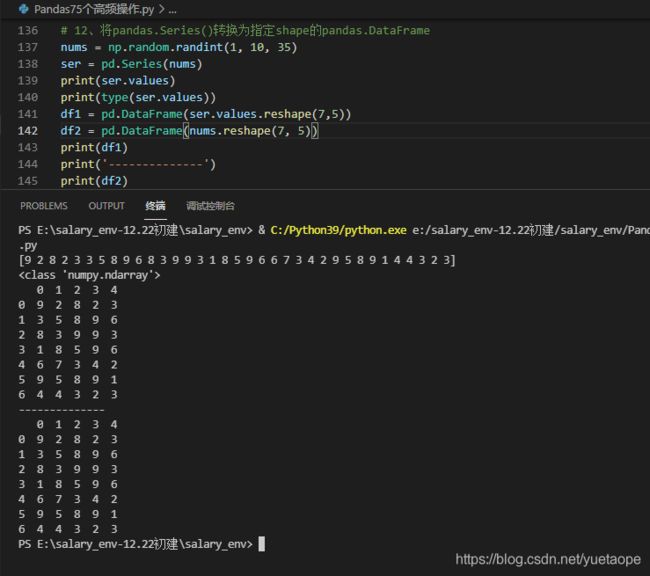
2.13、取出pandas.Series()中满足条件数据的位置index
np.random.seed(666)
ser = pd.Series(np.random.randint(1, 10, 15))
print(ser)
arr_i = np.argwhere(ser.values % 3 == 0)
print(type(arr_i))
print(arr_i)
print([i for i in arr_i])
print([i[0] for i in arr_i])

2.14、取出pandas.Series()指定位置的数据
ser = pd.Series(list('abcdefghijklmnopqrstuvwxyz'))
print(ser)
pos = [0, 4, 8, 14, 20]
print(ser.take(pos))

2.15、pandas.Series()水平、垂直合并
ser1 = pd.Series(range(5))
ser2 = pd.Series(list('abcde'))
ser3 = ser1.append(ser2)
print(ser3)
ser4 = pd.concat([ser1, ser2], axis=0)
print(ser4)
df = pd.concat([ser1, ser2], axis=1)
print(df)

2.16、输出pandas.Series()子集的index号
ser1 = pd.Series([10, 9, 6, 5, 3, 1, 12, 8, 13])
ser2 = pd.Series([1, 3, 10, 13])
print(np.where(ser1 == ser2[0]))
print(np.where(ser1 == ser2[0])[0])
print([np.where(ser1 == i)[0] for i in ser2])
print([np.where(ser1 == i)[0][0] for i in ser2])
print([np.where(ser1 == i)[0].tolist()[0] for i in ser2])
print([pd.Index(ser1).get_loc(i) for i in ser2])
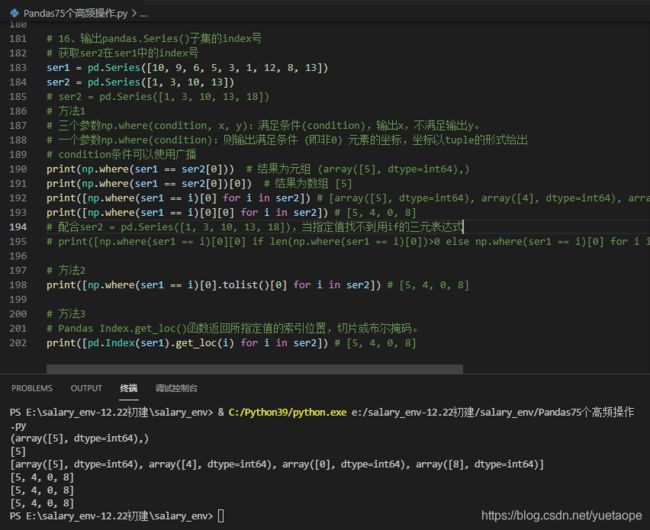
2.17、求真实和预测pd.Series之间的均方误差损失函数(MSE,mean squared error)
''' 17、求真实和预测pd.Series之间的均方误差损失函数(MSE,mean squared error) '''
truth = pd.Series(range(10))
pred = pd.Series(range(10)) + np.random.random(10)
print(np.mean((truth-pred)**2))

2.18、pd.Series字符串型数据首字母大写转换
''' 18、pd.Series字符串型数据首字母大写转换 '''
ser = pd.Series(['how', 'to', 'kick', 'ass?'])
print(ser.map(lambda x: x.title()))
print(ser.map(lambda x: x[0].upper() + x[1:]))
print(pd.Series([i.title() for i in ser]))
'''Series中的map()函数可以接受一个函数或含有映射关系的字典型对象,使用map()是一种实现元素级转换以及其他数据清理工作的便捷方式。(DataFrame中的对应的是applymap()函数以及apply()---对每一行操作,等同于axis=0)'''
data = pd.DataFrame({
'food':['bacon','pulled pork','bacon','Pastrami','corned beef','Bacon','pastrami','honey ham','nova lox'],
'ounces':[4,3,12,6,7.5,8,3,5,6]})
print(data)
meat_to_animal = {
'bacon':'pig',
'pulled pork':'pig',
'pastrami':'cow',
'corned beef':'cow',
'honey ham':'pig',
'nova lox':'salmon' }
data['animal'] = data['food'].map(str.lower).map(meat_to_animal)
print(data)

2.19、pd.Series字符串型数据字符长度计算
''' 19、pd.Series字符串型数据字符长度计算 '''
ser1 = pd.Series(['how', 'to', 'kick', 'ass?'])
print(ser1)
ser2 = ser1.map(lambda x: len(x))
print(ser2)
print(type(ser2))

2.20、pd.Series中两两数之间差异
''' 20、pd.Series中两两数之间差异 '''
ser = pd.Series([1, 3, 6, 10, 15, 21, 27, 35])
print(ser.diff().tolist())

2.21、pd.Series中日期字符串转换为datetime格式
''' 21、pd.Series中日期字符串转换为datetime格式 '''
ser = pd.Series(['01 Jan 2010', '02-02-2011', '20120303', '2013/04/04', '2014-05-05', '2015-06-06T12:20'])
print(ser)
from dateutil.parser import parse
print(ser.map(lambda x: parse(x)))
print(pd.to_datetime(ser))

2.22、获取pd.Series日期字符串中时间对象
''' 22、获取pd.Series日期字符串中时间对象 '''
ser = pd.Series(['01 Jan 2011', '02-02-2011', '20120303', '2013/04/04', '2014-05-05', '2015-06-06T12:20'])
print(ser)
from dateutil.parser import parse
ser_ts = ser.map(lambda x: parse(x))
print(ser_ts)
print("Date: ", ser_ts.dt.day.tolist())
print("Day number of year: ", ser_ts.dt.dayofyear.tolist())
print("Week number: ", ser_ts.dt.isocalendar().week)
print("df_isocalendar: ", ser_ts.dt.isocalendar())
print("Day of week: ", ser_ts.dt.day_name().tolist())

2.23、pd.Series日期字符串中修改为按指定日期输出
''' 23、pd.Series日期字符串中修改为按指定日期输出 '''
ser = pd.Series(['Jan 2010', 'Feb 2011', 'Mar 2012'])
print(pd.to_datetime(ser))
from dateutil.parser import parse
ser_ts = ser.map(lambda x: parse(x))
print(ser_ts)
ser_datestr = ser_ts.dt.year.astype('str') + '-' + ser_ts.dt.month.astype('str') + '-' + '04'
print(ser_datestr)
print('~~~~~~~~~~~~~', [parse(i).strftime('%Y-%m-%d') for i in ser_datestr])
print(ser.map(lambda x: parse('04' + x)))
print(ser.map(lambda x: parse(x + '55')))

2.24、输出pd.Series中至少包含两个元音字符的数据
''' 24、输出pd.Series中至少包含两个元音字符的数据 '''
ser = pd.Series(['Apple', 'Orange', 'Plan', 'Python', 'Money'])
from collections import Counter
print(ser.map(lambda x: [Counter(x.lower()).get(i, 0) for i in list('aeiou')]))
mask = ser.map(lambda x: sum([Counter(x.lower()).get(i, 0) for i in list('aeiou')]) >= 2)
print('apple中每个字母的次数:', Counter('Apple'.lower()))
print('计数器类型:', type(Counter('Apple'.lower())))
print('查找计数器中字母a的个数:', Counter('Apple'.lower()).get('a', 0))
print('查找计数器中字母i的个数:', Counter('Apple'.lower()).get('i', 0))
print(mask)
print(ser[mask])
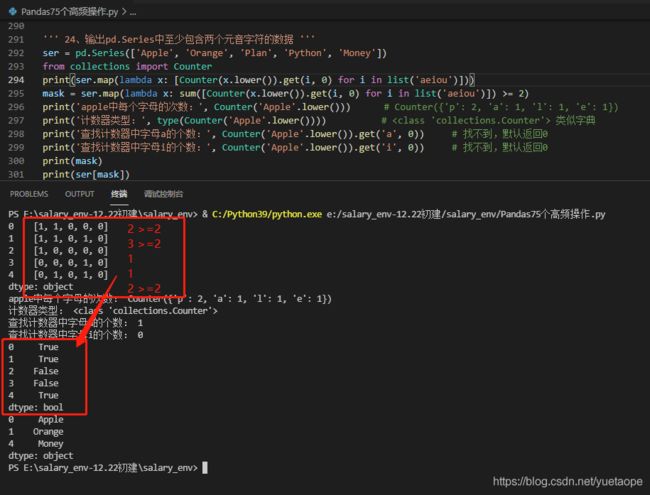
2.25、输出pd.Series中有效的email地址
''' 25、输出pd.Series中有效的email地址 '''
emails = pd.Series(['buying books at amazom.com', '[email protected]', '[email protected]', '[email protected]'])
import re
pattern ='[A-Za-z0-9._%+-]+@[A-Za-z0-9.-]+\\.[A-Za-z]{2,4}'
mask = emails.map(lambda x: bool(re.match(pattern, x)))
print(emails[mask])
print(emails.str.findall(pattern, flags=re.IGNORECASE))
print([x[0] for x in [re.findall(pattern, email) for email in emails] if len(x) > 0])
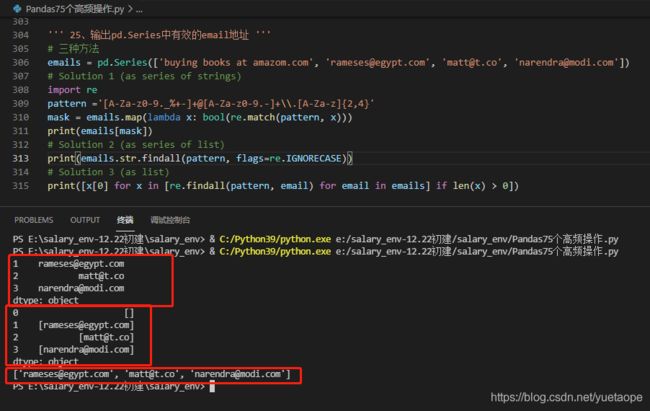
2.26、pd.Series1按pd.Series2分组并求均值
''' 26、pd.Series1按pd.Series2分组并求均值
numpy.linspace(start, stop, num=50, endpoint=True, retstep=False, dtype=None, axis=0) 主要用来创建等差数列。
start:返回样本数据开始点,stop:返回样本数据结束点,num:生成的样本数据量,默认为50,endpoint:True则包含stop;False则不包含stop
retstep:如果为True则结果会给出数据间隔,dtype:输出数组类型,axis:0(默认)或-1
'''
fruit = pd.Series(np.random.choice(['apple', 'banana', 'carrot'], 10))
weights = pd.Series(np.linspace(1, 10, 10))
weights1 = pd.Series(list(range(1,11)))
print(weights.groupby(fruit).mean())

2.27、计算两个pd.Series之间的欧式距离
欧式距离也称欧几里得距离,是最常见的距离度量,衡量的是多维空间中两个点之间的绝对距离。
也可以理解为:m维空间中两个点之间的真实距离,或者向量的自然长度(即该点到原点的距离)。在二维和三维空间中的欧氏距离就是两点之间的实际距离。计算公式:

''' 27、计算两个pd.Series之间的欧式距离 : 矩阵元素平方和,再开根号
np.linalg.norm(x, ord=None, axis=None, keepdims=False) # 求范数
①x: 表示矩阵(也可以是一维);②ord:范数类型,ord=None:默认情况下,是求整体的矩阵元素平方和,再开根号。
ord=2-2范数,求特征值,然后求最大特征值得算术平方根;ord=1-1范数,求列和的最大值;ord=np.inf无穷范数,求行和的最大值;
'''
p = pd.Series([1, 2, 3, 4, 5, 6, 7, 8, 9, 10])
q = pd.Series([10, 9, 8, 7, 6, 5, 4, 3, 2, 1])
print('欧式距离:', sum((p - q)**2)**.5)
print("默认参数(矩阵整体元素平方和开根号,不保留矩阵二维特性):", np.linalg.norm(p-q))

2.28、求pd.Series局部峰值index
''' 28、求pd.Series局部峰值index
numpy.diff(a, n=1,axis=-1),沿着指定轴计算第N维的离散差值,后一个元素减去前一个元素,a:输入矩阵,n:可选,代表要执行几次差值,axis:默认是最后一个
np.sign(x),取数字x的符号(数字前的正负号),x>0返回1,x<0返回-1,x=0返回0
'''
ser = pd.Series([2, 10, 3, 4, 9, 10, 2, 7, 3])
print(np.diff(ser))
print(np.sign(np.diff(ser)))
dd = np.diff(np.sign(np.diff(ser)))
print(dd)
peak_locs = np.where(dd == -2)[0] + 1
print(peak_locs)

2.29、pd.Series字符串数据中使用最低频字符填充空格
''' 29、pd.Series字符串数据中使用最低频字符填充空格 '''
ser = pd.Series(list('dbc deb abed gade'))
freq = ser.value_counts()
print(freq)
print(freq.index)
least_freq = freq.index[-1]
str = "".join(ser.replace(' ', least_freq))
print(str)

2.30、创建时间序列数据,赋予随机值
''' 30、创建时间序列数据,赋予随机值
pandas.date_range(start=None, end=None, periods=None, freq='D', tz=None, normalize=False, name=None, closed=None, **kwargs)
该函数主要用于生成一个固定频率的时间索引,在调用构造方法时,必须指定start、end、periods中的两个参数值,否则报错。
主要参数说明:
periods:固定时期,取值为整数或None
freq:日期偏移量,取值为string或DateOffset,默认为'D',
默认freq = 'D':每日历日,B:每工作日,H:每小时,T/MIN:每分,S:每秒,L:每毫秒(千分之一秒),U:每微秒(百万分之一秒)
freq = 'W-MON':每周从指定星期几开始算起,这里是周一。星期几缩写:MON/TUE/WED/THU/FRI/SAT/SUN
freq = 'WOM-2MON':每月的第几个星期几开始算,这里是每月第二个星期一
freq = 'M':M:每月最后一个日历日;Q-月:指定月为季度末,每个季度末最后一月的最后一个日历日;A-月:每年指定月份的最后一个日历日
月缩写:JAN/FEB/MAR/APR/MAY/JUN/JUL/AUG/SEP/OCT/NOV/DEC;所以Q-月只有三种情况:1-4-7-10,2-5-8-11,3-6-9-12
freq = 'BM':BM:每月最后一个工作日;BQ-月:指定月为季度末,每个季度末最后一月的最后一个工作日;BA-月:每年指定月份的最后一个工作日
freq = 'MS':M:每月第一个日历日;Q-月:指定月为季度末,每个季度末最后一月的第一个日历日;A-月:每年指定月份的第一个日历日
freq = 'BMS':BM:每月第一个工作日;BQ-月:指定月为季度末,每个季度末最后一月的第一个工作日;BA-月:每年指定月份的第一个工作日
freq = '7D':7天
freq = '2h30min':2小时30分钟
freq = '2M':2月,每月最后一个日历日
normalize:若参数为True表示将start、end参数值正则化到午夜时间戳
name:生成时间索引对象的名称,取值为string或None
closed:可以理解成在closed=None情况下返回的结果中,若closed=‘left’表示在返回的结果基础上,再取左开右闭的结果,
若closed='right'表示在返回的结果基础上,再取做闭右开的结果
'''
ser = pd.Series(np.random.randint(1,10,10), pd.date_range('2000-01-01', periods=10, freq='W-SAT'))
print(ser)
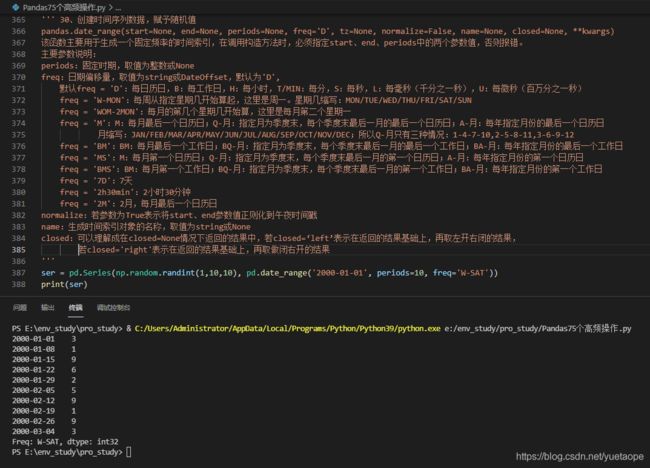
2.31、缺省的时间序列值 不同方式填充
''' 31、缺省的时间序列值 不同方式填充
resample()是一个对常规时间序列数据重新采样和频率转换的便捷的方法,可以对原样本重新处理,
resample(rule,how=None,axis=0,fill_method=None,closed=None,label=None,convention=“start”,kind=None,loffset=None,limit=None,base=0,on=None,level=None)
rule:表示重采样频率的字符串或DateOffset,比如D(天)、M(月)、5min(5分钟)、5D(5天)、2M(2个月)、60T(60分钟)等。
how:用于产生聚合值的函数名或函数数组,默认为None。
fill_method:表示升采样时如何插值,可以取值为fill、bfill或None,默认为None。
closed:设置降采样哪一端是闭合的,可以取值为right或left。若设为right,则表示划分为左开右闭的区间;若设为left,则表示划分为左闭右开的区间。
label:表示降采样时设置聚合值的标签。
convention:重采样日期时,低频转高频采用的约定,可以取值为start或end,默认为start。
limit:表示前向或后向填充时,允许填充的最大时期数。
ser.resample('60T', base=30):base=30时,60分钟的时间间隔将移动30分钟
'''
ser = pd.Series([1,10,3, np.nan], index=pd.to_datetime(['2000-01-01', '2000-01-03', '2000-01-06', '2000-01-08']))
print(ser)
f_ser = ser.resample('D').ffill()
print(f_ser)
b_ser = ser.resample('D').bfill()
print(b_ser)
bf_ser = ser.resample('D').bfill().ffill()
print(bf_ser)

2.32、找出pd.Series中自相关性最大的数据
''' 32、找出pd.Series中自相关性最大的数据
numpy.random.normal(loc=0,scale=1e-2,size=shape) 随机生成一个正态分布
loc(float):正态分布的均值,对应着这个分布的中心。loc=0说明这一个以Y轴为对称轴的正态分布,
scale(float):正态分布的标准差,对应分布的宽度,scale越大,正态分布的曲线越矮胖,scale越小,曲线越高瘦。
size(int 或者整数元组):输出的值赋在shape里,默认为None。
Series.autocorr(lag=1)函数计算lag-N自相关,lag:执行自相关之前要应用的滞后次数。
np.abs(x)、np.fabs(x):计算数组各元素的绝对值
np.argmax(array, axis):用于返回一个numpy数组中最大值的索引值。
'''
ser = pd.Series(np.arange(20) + np.random.normal(1, 10, 20))
print(np.random.normal(1, 10, 20))
print(np.arange(20) + np.random.normal(1, 10, 20))
autocorrelations = [ser.autocorr(lag = i).round(2) for i in range(18)]
print(autocorrelations)
print('\n Lag 自相关性最大的位置: ', np.argmax(np.abs(autocorrelations[1:]))+1, '\n')

2.33、从一个csv 文件中每间隔50行取数据生成pandas.DataFrame
''' 33、从一个csv 文件中每间隔50行取数据生成pandas.DataFrame '''
df = pd.read_csv('datasets/BostonHousing.csv', chunksize=50)
df2 = pd.DataFrame()
for chunk in df:
df2 = df2.append(chunk.iloc[0,:])
print(df2.head(2))
df = pd.read_csv('datasets/BostonHousing.csv', chunksize=50)
df3 = pd.concat([chunk.iloc[0] for chunk in df], axis=1)
df3 = df3.transpose()
print(df3.head(2))
import csv
with open('datasets/BostonHousing.csv', 'r') as f:
reader = csv.reader(f)
out = []
for i, row in enumerate(reader):
if i%50 == 0:
out.append(row)
df4 = pd.DataFrame(out[1:], columns=out[0])
print(df4.head(2))

2.34、从一个csv 文件取数据生成pandas.DataFrame(新增加一分类列)
''' 34、从一个csv 文件取数据生成pandas.DataFrame(新增加一分类列) '''
df = pd.read_csv('datasets/BostonHousing.csv',
converters={
'medv': lambda x: 'High' if float(x) > 25 else 'Low'})
print(df.head())
import csv
with open('datasets/BostonHousing.csv', 'r') as f:
reader = csv.reader(f)
out = []
for i, row in enumerate(reader):
if i > 0:
row[13] = 'High' if float(row[13]) > 25 else 'Low'
out.append(row)
print(out[:3])
df = pd.DataFrame(out[1:], columns=out[0])
print(df.head())
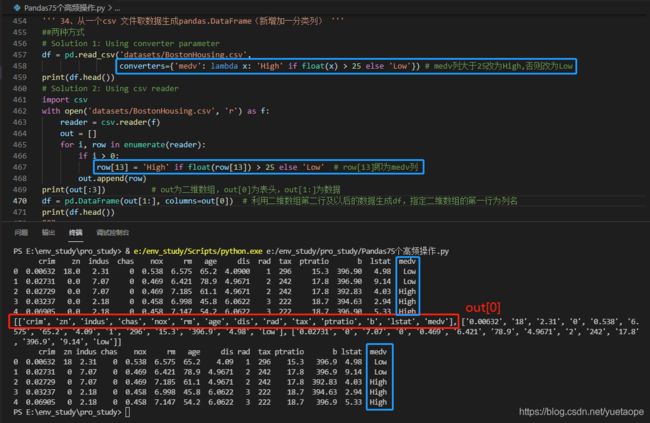
2.35、生成一个按规定步长平移的pandas.DataFrame
''' 35、生成一个按规定步长平移的pandas.DataFrame '''
L = pd.Series(range(15))
def gen_strides(a, stride_len=5, window_len=5):
n_strides = ((a.size-window_len)//stride_len) + 1
return np.array([a[s:(s+window_len)] for s in np.arange(0, a.size, stride_len)[:n_strides]])
result = gen_strides(L, stride_len=2, window_len=4)
print(result)

2.36、从一个csv 文件读取指定列生成pandas.DataFrame
''' 36、从一个csv 文件读取指定列生成pandas.DataFrame '''
df = pd.read_csv('https://raw.githubusercontent.com/selva86/datasets/master/BostonHousing.csv', usecols=['crim', 'medv'])
print(df.head())

2.37、输出DataFrame的行数、列数、数据类型、类型频数、Series转list
''' 37、输出DataFrame的行数、列数、数据类型、类型频数、Series转list '''
df = pd.read_csv('datasets/Cars93_miss.csv')
print(df.shape)
print(df.dtypes.head())
print(df.dtypes.value_counts())
print(df.describe())
print(df['Model'].tolist()[:5])

2.38、输出满足某个规则的DataFrame数据行和列号
''' 38、输出满足某个规则的DataFrame数据行和列号
np.where(condition):只有条件 (condition),没有x和y,则输出满足条件 (即非0) 元素的坐标.
坐标以tuple的形式给出,原数组有多少维,输出的tuple中就包含几个数组,分别对应符合条件元素的各维坐标。
'''
df = pd.read_csv('datasets/Cars93_miss.csv')
print(df)
print(df.values == np.max(df.Price))
result = np.where(df.values == np.max(df.Price))
print(result)
row, col = np.where(df.values == np.max(df.Price))
print(f'\n 行号:{
row},列号:{
col} \n')
print((df.values == np.max(df.Price))[row[0]][col[0]])

2.39、修改DataFrame的列名称
''' 39、修改DataFrame的列名称 '''
df = pd.read_csv('datasets/Cars93_miss.csv')
print(df.columns)
df1=df.rename(columns = {
'Type':'CarType'})
print(df1.columns)
df.columns = df.columns.map(lambda x: x.replace('.', '_'))
print(df.columns)

2.40、DataFrame中是否有缺省值确认
''' 40、DataFrame中是否有缺失值确认
DataFrame.any()与all():any()一个序列中满足一个True,则返回True;all()一个序列中所有值为True时,返回True
'''
df = pd.read_csv('datasets/Cars93_miss.csv')
print(df)
print(df.isnull())
print(df.isnull().values)
print(df.isnull().values.any())

2.41、DataFrame中缺省值统计
''' 41、DataFrame中缺省值统计 '''
df = pd.read_csv('datasets/Cars93_miss.csv')
n_missings_each_col = df.apply(lambda x: x.isnull().sum())
print(n_missings_each_col)
print(n_missings_each_col.argmax())

2.42、各自列均值填充DataFrame中各自列缺省值
''' 42、各自列均值填充DataFrame中各自列缺省值 '''
df = pd.read_csv('datasets/Cars93_miss.csv')
df_out = df[['Min.Price', 'Max.Price']].apply(lambda x: x.fillna(x.mean()))
print(df_out.head())

2.43、各自列均值、中值填充DataFrame中各自列缺省值(使用apply)
''' 43、各自列均值、中值填充DataFrame中各自列缺省值(使用apply) '''
df = pd.read_csv('datasets/Cars93_miss.csv')
d = {
'Min.Price': np.nanmean, 'Max.Price': np.nanmedian}
df[['Min.Price', 'Max.Price']] = df[['Min.Price', 'Max.Price']].apply(lambda x, d: x.fillna(d[x.name](x)), args=(d, ))
print(df[['Min.Price', 'Max.Price']])

2.44、从DataFrame选择子DataFrame
''' 44、从DataFrame选择子DataFrame '''
df = pd.DataFrame(np.arange(20).reshape(-1, 5), columns=list('abcde'))
print(type(df[['a']]))
print(type(df.loc[:, ['a']]))
print(type(df.iloc[:, [0]]))
print(type(df.a))
print(type(df['a']))
print(type(df.loc[:, 'a']))
print(type(df.iloc[:, 1]))

2.45、 改变DataFrame列顺序
''' 45、 改变DataFrame列顺序 '''
df = pd.DataFrame(np.arange(20).reshape(-1, 5), columns=list('abcde'))
df1= df[list('cbade')]
print(df1.head(2))
def switch_columns(df, col1=None, col2=None):
colnames = df.columns.tolist()
i1, i2 = colnames.index(col1), colnames.index(col2)
colnames[i2], colnames[i1] = colnames[i1], colnames[i2]
return df[colnames]
df2 = switch_columns(df, 'a', 'c')
print(df2.head(2))
df3 = df[sorted(df.columns)]
print(df3.head(2))
df4 = df.sort_index(axis=1, ascending=False)
print(df4.head(2))

2.46、大DataFrame修改默认显示的行和列数
''' 46、大DataFrame修改默认显示的行和列数 '''
df = pd.read_csv('datasets/Cars93_miss.csv')
pd.set_option('display.max_columns', 10)
pd.set_option('display.max_rows', 10)
print(df)

2.47、DataFrame数据小数位数设置
''' 47、DataFrame数据小数位数设置 '''
df = pd.DataFrame(np.random.random(4), columns=['random'])
print(df)
df1 = df.round(4)
print(df1)
df3 = df.apply(lambda x: '%.4f' % x, axis=1)
print(df3)
df4 = df.applymap(lambda x: '%.4f' % x)
print(df4)
df5 = pd.set_option('display.float_format', lambda x: '%.4f' % x)
print(df5)
pd.options.display.float_format = '{:.4f}'.format
print(df)

2.48、 DataFrame数据小数转百分比显示
''' 48、 DataFrame数据小数转百分比显示 '''
df = pd.DataFrame(np.random.random(4), columns=['random'])
print(df)
df1 = df.applymap(lambda x: '%.2f%%' % (x*100))
print(df1)

2.49、DataFrame数据每隔20行读取
''' 49、DataFrame数据每隔20行读取 '''
df = pd.read_csv('datasets/Cars93_miss.csv')
print(df.iloc[::20, :][['Manufacturer', 'Model', 'Type']])

2.50、创建DataFrame主键
''' 50、创建DataFrame主键 '''
df = pd.read_csv('datasets/Cars93_miss.csv', usecols=[0,1,2,3,5])
df[['Manufacturer', 'Model', 'Type']] = df[['Manufacturer', 'Model', 'Type']].fillna('missing')
df.index = df.Manufacturer + '_' + df.Model + '_' + df.Type
print(df)
print(df.index.is_unique)

2.51、获取DataFrame某一列中第n大的值索引
''' 51、获取DataFrame某一列中第n大的值索引
Series.argsort(axis=0, kind='quicksort', order=None) # 对series值进行排序的整数索引。
'''
df = pd.DataFrame(np.random.randint(1, 30, 21).reshape(-1,3), columns=list('abc'))
print(df['a'])
print(df['a'].sort_values())
print(df['a'].sort_values()[::-1])
print(df['a'].sort_values()[::-1][1:3].index)
print(df['a'].sort_values()[::-1][1:3].index[0])

2.52、获取DataFrame某一列中第n大的值大于指定值得索引
''' 52、获取DataFrame某一列中第n大的值大于指定值的索引 '''
ser = pd.Series(np.random.randint(1, 100, 15))
print('ser: ', ser.tolist(), 'mean: ', round(ser.mean()))
print(np.where(ser > round(ser.mean()))[0])

2.53、获取DataFrame中行和大于100的行
''' 53、获取DataFrame中行和大于100的行 '''
df = pd.DataFrame(np.random.randint(10, 40, 60).reshape(-1, 4))
rowsums = df.apply(np.sum, axis=1)
print(rowsums)
print(df.iloc[np.where(rowsums > 110)])
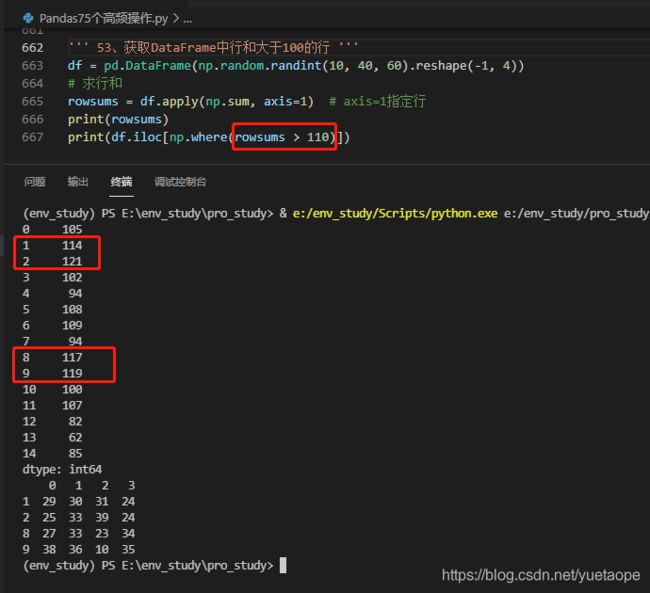
2.54、 Series or DataFrame中使用分位数填充超限区域
''' 54、 Series or DataFrame中使用分位数填充超限区域
np.logspace(start=指数开始值,stop=指数结束值,num=个数,base=对数的底(默认为10), endpoint=包含结束值(默认包含)) # 对数等比数列
'''
ser = pd.Series(np.logspace(-2, 2, 30))
print(ser.round(4).tolist())
def cap_outliers(ser, low_perc, high_perc):
low, high = ser.quantile([low_perc, high_perc])
print(low_perc, '%ile: ', low, '|', high_perc, '%ile: ', high)
ser[ser < low] = low
ser[ser > high] = high
return(ser)
capped_ser = cap_outliers(ser, .05, .95)
print(capped_ser.tolist())

2.55、去除指定值将DataFrame转换为最大方阵
''' 55、去除指定值将DataFrame转换为最大方阵 '''
df = pd.DataFrame(np.random.randint(-20, 50, 100).reshape(10,-1))
print(df)
arr = df[df > 0].values.flatten()
arr_qualified = arr[~np.isnan(arr)]
n = int(np.floor(arr_qualified.shape[0]**.5))
top_indexes = np.argsort(arr_qualified)[::-1]
output = np.take(arr_qualified, sorted(top_indexes[:n**2])).reshape(n, -1)
print(output)

2.56、DataFrame两行交换
''' 56、DataFrame两行交换 '''
df = pd.DataFrame(np.arange(25).reshape(5, -1))
print(df)
def swap_rows(df, i1, i2):
a, b = df.iloc[i1, :].copy(), df.iloc[i2, :].copy()
df.iloc[i1, :], df.iloc[i2, :] = b, a
return df
print(swap_rows(df, 1, 2))

2.57、DataFrame逆序输出
''' 57、DataFrame逆序输出 '''
df = pd.DataFrame(np.arange(25).reshape(5, -1))
print(df)
df.iloc[::-1, :]
print(df.loc[df.index[::-1], :])

2.58、DataFrame转对角矩阵
''' 58、DataFrame转对角矩阵
pd.get_dummies()特征提取,one-hot encoding的基本思想:将离散型特征的每一种取值都看成一种状态,若你的这一特征中有N个不相同的取值,
那么我们就可以将该特征抽象成N种不同的状态,one-hot编码保证了每一个取值只会使得一种状态处于“激活态”,
也就是说这N种状态中只有一个状态位值为1,其他状态位都是0。
'''
df = pd.DataFrame(np.arange(25).reshape(5,-1), columns=list('abcde'))
print(df)
df_onehot = pd.concat([pd.get_dummies(df['a']), df[list('bcde')]], axis=1)
print(df_onehot)

2.59、DataFrame那一列含有最多行最大值
''' 59、DataFrame那一列含有最大值最多的行 '''
df = pd.DataFrame(np.random.randint(1,100, 40).reshape(10, -1))
print(df)
print(df.apply(np.argmax, axis=1))
print(df.apply(np.argmax, axis=1).value_counts())
print(df.apply(np.argmax, axis=1).value_counts().index)
print('最大值最多的行: ', df.apply(np.argmax, axis=1).value_counts().index[0])
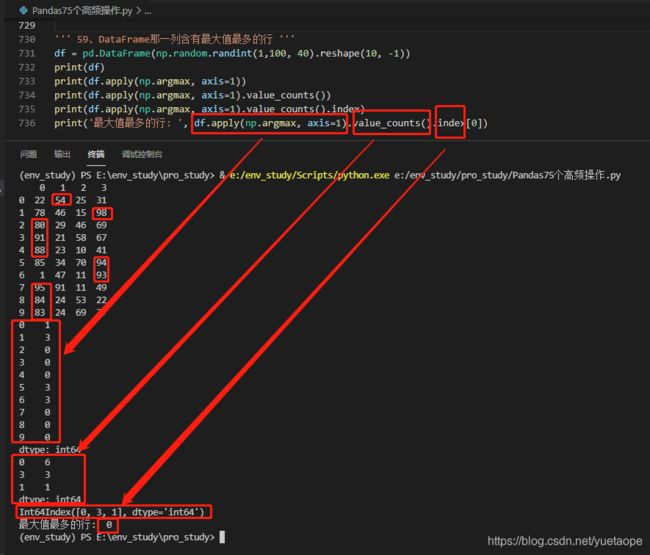
2.60、DataFrame创建新列:每行为行号(按欧几里得距离而来)
''' 60、DataFrame创建新列:每行为行号(按欧几里得距离而来) '''
df = pd.DataFrame(np.random.randint(1,100, 40).reshape(5, -1), columns=list('abcdefgh'), index=list('mnprs'))
print(df)
nearest_rows = []
nearest_distance = []
for i, row in df.iterrows():
curr = row
rest = df.drop(i)
e_dists = {
}
for j, contestant in rest.iterrows():
e_dists.update({
j: round(np.linalg.norm(curr.values - contestant.values))})
nearest_rows.append(max(e_dists, key=e_dists.get))
nearest_distance.append(max(e_dists.values()))
df['nearest_row'] = nearest_rows
df['dist'] = nearest_distance
print(df)

2.61、求DataFrame各列之间最大相关系数
''' 61、求DataFrame各列之间「最大」相关系数 '''
df = pd.DataFrame(np.random.randint(1,100, 80).reshape(8, -1), columns=list('pqrstuvwxy'), index=list('abcdefgh'))
print(df)
abs_corrmat = np.abs(df.corr())
print(abs_corrmat)
max_corr = abs_corrmat.apply(lambda x: sorted(x)[-2])
print('Maximum Correlation possible for each column: \n', np.round(max_corr.tolist(), 4))

2.62、DataFrame创建一列:包含每行中最小值与最大值比值
''' 62、DataFrame创建一列:包含每行中最小值与最大值比值 '''
df = pd.DataFrame(np.random.randint(1,100, 80).reshape(8, -1))
print(df)
min_by_max = df.apply(lambda x: np.min(x)/np.max(x), axis=1)
print(min_by_max)
min_by_max = np.min(df, axis=1)/np.max(df, axis=1)
print(min_by_max)

2.63、DataFrame创建一列:包含每行中第二大的值
''' 2.63、DataFrame创建一列:包含每行中第二大的值 '''
df = pd.DataFrame(np.random.randint(1,100, 80).reshape(8, -1))
print(df)
out = df.apply(lambda x: x.sort_values().unique()[-2], axis=1)
df['penultimate'] = out
print(df)

2.64、DataFrame每列按特定方式归一化
''' 64、DataFrame每列按特定方式归一化 '''
df = pd.DataFrame(np.random.randint(1,100, 80).reshape(8, -1))
print(df)
out1 = df.apply(lambda x: ((x - x.mean())/x.std()).round(2))
print('均值、标准差归一化:\n',out1)
out2 = df.apply(lambda x: ((x.max() - x)/(x.max() - x.min())).round(2))
print('最大最小值归一化:\n', out2)

2.65、计算DataFrame每行与后一行的相关系数
''' 65、计算DataFrame每行与后一行的相关系数 '''
df = pd.DataFrame(np.random.randint(1,100, 80).reshape(8, -1))
print(df)
print([df.iloc[i].corr(df.iloc[i+1]).round(2) for i in range(df.shape[0])[:-1]])

2.66、DataFrame对角线元素替换为0
''' 66、DataFrame对角线元素替换为0 '''
df = pd.DataFrame(np.random.randint(1,100, 100).reshape(10, -1))
print(df)
for i in range(df.shape[0]):
df.iat[i, i] = 0
df.iat[df.shape[0]-i-1, i] = 0
print(df)

2.67、DataFrame按某列分组、提取某个分组
''' 67、DataFrame按某列分组、提取某个分组 '''
df = pd.DataFrame({
'col1': ['apple', 'banana', 'orange'] * 3,
'col2': np.random.rand(9),
'col3': np.random.randint(0, 15, 9)})
print(df)
df_grouped = df.groupby(['col1'])
df1= df_grouped.get_group('apple')
print(df1)
for i, dff in df_grouped:
if i == 'apple':
print(dff)

2.68、DataFrame按另外列分组、提取当前列中指定值(看下方例子,需求不好描述)
''' 68、DataFrame按另外列分组、提取当前列中指定值(看下方例子,需求不好描述) '''
df = pd.DataFrame({
'fruit': ['apple', 'banana', 'orange'] * 3,
'taste': np.random.rand(9),
'price': np.random.randint(0, 15, 9)})
print(df)
df_grpd = df['taste'].groupby(df.fruit)
print(df_grpd.get_group('banana'))
print(df_grpd.get_group('banana').sort_values())
print(df_grpd.get_group('banana').sort_values().iloc[-2])

2.69、DataFrame分组(看下方例子,需求不好描述)
''' 69、DataFrame分组(看下方例子,需求不好描述) '''
df = pd.DataFrame({
'fruit': ['apple', 'banana', 'orange'] * 3,
'rating': np.random.rand(9),
'price': np.random.randint(0, 15, 9)})
print(df)
print(df.groupby('fruit', as_index=False))
print(df.groupby('fruit', as_index=False)['price'])
print(df.groupby('fruit', as_index=False)['price'].mean())

2.70、两个DataFrame使用类似SQL 中INNER JOIN拼接
''' 70、两个DataFrame使用类似SQL 中INNER JOIN拼接 '''
df1 = pd.DataFrame({
'fruit': ['apple', 'banana', 'orange'] * 3,
'weight': ['high', 'medium', 'low'] * 3,
'price': np.random.randint(0, 15, 9)
})
df2 = pd.DataFrame({
'pazham': ['apple', 'orange', 'pine'] * 2,
'kilo': ['high', 'low'] * 3,
'price': np.random.randint(0, 15, 6)
})
df3 = pd.merge(df1, df2, how='inner', left_on=['fruit', 'weight'], right_on=['pazham', 'kilo'], suffixes=['_left', '_right'])
print(df3)

2.71、移除DataFrame1中在DataFrame2出现的行
''' 71、移除DataFrame1中在DataFrame2出现的行
Series.all(axis=0, bool_only=None, skipna=True, level=None, **kwargs) # 函数返回是否所有元素都为True(可能在某个轴上)'''
df1 = pd.DataFrame({
'fruit': ['apple', 'orange', 'banana'] * 3,
'weight': ['high', 'medium', 'low'] * 3,
'price': np.arange(9) })
print(df1)
df2 = pd.DataFrame({
'fruit': ['apple', 'orange', 'pine'] * 2,
'weight': ['high', 'medium'] * 3,
'price': np.arange(6) })
print(df2)
print(df1[~df1.isin(df2).all(axis=1)])

2.72、取出DataFrame中两列值相等的行号
''' 72、取出DataFrame中两列值相等的行号 '''
df = pd.DataFrame({
'fruit1': np.random.choice(['apple', 'orange', 'banana'], 10),
'fruit2': np.random.choice(['apple', 'orange', 'banana'], 10)
})
print(df)
print(np.where(df.fruit1 == df.fruit2))

2.73、DataFrame中新建两列:滞后列和提前列(看下方例子,需求BT)
''' 73、DataFrame中新建两列:滞后列和提前列(看下方例子,需求BT) '''
df = pd.DataFrame(np.random.randint(1, 100, 20).reshape(-1, 4), columns=list('abcd'))
print(df)
df['a_lag1'] = df['a'].shift(1)
df['b_lead1'] = df['b'].shift(-1)
print(df)

2.74、DataFrame中所有值出现频次统计
''' 74、DataFrame中所有值出现频次统计
numpy中的ravel()、flatten()、squeeze()都有将多维数组转换为一维数组的功能,区别:
ravel():如果没有必要,不会产生源数据的副本
flatten():返回源数据的副本,平时使用的时候flatten()更为合适
squeeze():只能对维数为1的维度降维
另外,reshape(-1)也可以“拉平”多维数组
'''
df = pd.DataFrame(np.random.randint(1, 10, 20).reshape(-1, 4), columns=list('abcd'))
print(df)
print(df.values.ravel())
print(pd.value_counts(df.values.ravel()))

2.75、拆分DataFrame中某列文本为两列
''' 75、拆分DataFrame中某列文本为两列 '''
df = pd.DataFrame(["STD, City State", "33, Kolkata West Bengal", "44, Chennai Tamil Nadu", "40, Hyderabad Telengana",
"80, Bangalore Karnataka"], columns=['row'])
print(df)
print(df.columns)
df_out = df.row.str.split(',|\t', expand=True)
new_header = df_out.iloc[0]
df_out = df_out[1:]
df_out.columns = new_header
print(df_out)
print(df_out.columns)

2.100 代码块
import pandas as pd
import numpy as np
''' 1、pandas导入、查看版本'''
import pandas as pd
print(pd.__version__)
print(pd.show_versions(as_json=True))
print(pd.show_versions())
''' 2、使用python list、python dict、numpy.ndarray创建pandas.Series '''
mylist = list('abcedfghijklmnopqrstuvwxyz')
myarr = np.arange(26)
mydict = dict(zip(mylist, myarr))
ser1 = pd.Series(mylist)
ser2 = pd.Series(myarr)
ser3 = pd.Series(mydict)
print(ser1.head(3))
print(ser2.head(3))
print(ser3.head(3))
''' 3、将pandas.Series转化为pandas.DataFrame '''
mylist = list('abcedfghijklmnopqrstuvwxyz')
myarr = np.arange(26)
mydict = dict(zip(mylist, myarr))
ser = pd.Series(mydict)
df = ser.to_frame().reset_index()
print(type(df))
print(df.head())
''' 4、将多个pandas.Series合并为一个pandas.DataFrame '''
ser1 = pd.Series(list('abcedfghijklmnopqrstuvwxyz'))
ser2 = pd.Series(np.arange(26))
df = pd.concat([ser1, ser2], axis=1)
print('1-------------')
print(df.head())
df = pd.DataFrame({
'col1': ser1, 'col2': ser2})
print('2-------------')
print(df.head())
''' 5、修改pandas.Series index名称 '''
ser = pd.Series(list('abcedfghijklmnopqrstuvwxyz'))
print(ser.head(3))
print(f'原始Sersies index名称:{
ser.name}')
ser.name = 'alphabets'
print(ser.head(3))
print(f'修改后Sersies index名称:{
ser.name}')
''' 6、 pandas.Series1中移除pandas.Series1中和pandas.Series2共同的部分--差集 '''
ser1 = pd.Series([1, 2, 3, 4, 5])
ser2 = pd.Series([4, 5, 6, 7, 8])
ser3 = ser1[~ser1.isin(ser2)]
print(ser3)
''' 7、求pandas.Series1和pandas.Series2的交集、并集、差集 '''
ser1 = pd.Series([1, 2, 3, 4, 5])
ser2 = pd.Series([4, 5, 6, 7, 8])
ser_i = pd.Series(np.intersect1d(ser1, ser2))
ser_u = pd.Series(np.union1d(ser1, ser2))
ser_s = ser_u[~ser_u.isin(ser_i)]
print("交集-------")
print(ser_i)
print("并集-------")
print(ser_u)
print("差集-------")
print(ser_s)
''' 8、求pandas.Series分位数(最小值、1/4分位数、中位数、3/4分位数、最大值) '''
state = np.random.RandomState(100)
ser = pd.Series(state.normal(10, 5, 25))
print(ser)
print(np.percentile(ser, q=[0, 25, 50, 75, 100]))
''' 9、求pandas.Series()频数 '''
arr = list('abcdefgh')
indices = np.random.randint(8, size=30)
ser = pd.Series(np.take(arr, indices))
print(ser)
print(ser.value_counts())
''' 10、输出pandas.Series()中频数排第一二位的、其它的替换为other '''
ser = pd.Series(np.random.randint(1, 6, 12))
print(ser)
print(ser.value_counts())
ser[~ser.isin(ser.value_counts().index[:2])] = 'Other'
print(ser)
''' 11、将pandas.Series()均分为10个区间、每个值使用区间名称标记 '''
np.random.seed(666)
ser = pd.Series(np.random.random(20))
print(ser)
ser_qcut = pd.qcut(ser,
q=[0, 0.1, 0.2, 0.3, 0.4, 0.5, 0.6, 0.7, 0.8, 0.9, 1],
labels=['1st', '2nd', '3rd', '4th', '5th', '6th', '7th', '8th', '9th','10th']
)
print(ser_qcut)
''' 12、将pandas.Series()转换为指定shape的pandas.DataFrame '''
nums = np.random.randint(1, 10, 35)
ser = pd.Series(nums)
print(ser.values)
print(type(ser.values))
df1 = pd.DataFrame(ser.values.reshape(7,5))
df2 = pd.DataFrame(nums.reshape(7, 5))
print(df1)
print('--------------')
print(df2)
''' 13、取出pandas.Series()中满足条件数据的位置index '''
np.random.seed(666)
ser = pd.Series(np.random.randint(1, 10, 15))
print(ser)
arr_i = np.argwhere(ser.values % 3 == 0)
print(type(arr_i))
print(arr_i)
print([i for i in arr_i])
print([i[0] for i in arr_i])
''' 14、取出pandas.Series()指定位置的数据 '''
ser = pd.Series(list('abcdefghijklmnopqrstuvwxyz'))
print(ser)
pos = [0, 4, 8, 14, 20]
print(ser.take(pos))
''' 15、pandas.Series()水平、垂直合并 '''
ser1 = pd.Series(range(5))
ser2 = pd.Series(list('abcde'))
ser3 = ser1.append(ser2)
print(ser3)
ser4 = pd.concat([ser1, ser2], axis=0)
print(ser4)
df = pd.concat([ser1, ser2], axis=1)
print(df)
''' 16、输出pandas.Series()子集的index号 '''
ser1 = pd.Series([10, 9, 6, 5, 3, 1, 12, 8, 13])
ser2 = pd.Series([1, 3, 10, 13])
print(np.where(ser1 == ser2[0]))
print(np.where(ser1 == ser2[0])[0])
print([np.where(ser1 == i)[0] for i in ser2])
print([np.where(ser1 == i)[0][0] for i in ser2])
print([np.where(ser1 == i)[0].tolist()[0] for i in ser2])
print([pd.Index(ser1).get_loc(i) for i in ser2])
''' 17、求真实和预测pd.Series之间的均方误差损失函数(MSE,mean squared error) '''
truth = pd.Series(range(10))
pred = pd.Series(range(10)) + np.random.random(10)
print(np.mean((truth-pred)**2))
''' 18、pd.Series字符串型数据首字母大写转换 '''
ser = pd.Series(['how', 'to', 'kick', 'ass?'])
print(ser.map(lambda x: x.title()))
print(ser.map(lambda x: x[0].upper() + x[1:]))
print(pd.Series([i.title() for i in ser]))
'''Series中的map()函数可以接受一个函数或含有映射关系的字典型对象,使用map()是一种实现元素级转换以及其他数据清理工作的便捷方式。(DataFrame中的对应的是applymap()函数以及apply()---对每一行操作,等同于axis=0)'''
data = pd.DataFrame({
'food':['bacon','pulled pork','bacon','Pastrami','corned beef','Bacon','pastrami','honey ham','nova lox'],
'ounces':[4,3,12,6,7.5,8,3,5,6]})
print(data)
meat_to_animal = {
'bacon':'pig',
'pulled pork':'pig',
'pastrami':'cow',
'corned beef':'cow',
'honey ham':'pig',
'nova lox':'salmon' }
data['animal'] = data['food'].map(str.lower).map(meat_to_animal)
print(data)
''' 19、pd.Series字符串型数据字符长度计算 '''
ser1 = pd.Series(['how', 'to', 'kick', 'ass?'])
print(ser1)
ser2 = ser1.map(lambda x: len(x))
print(ser2)
print(type(ser2))
''' 20、pd.Series中两两数之间差异 '''
ser = pd.Series([1, 3, 6, 10, 15, 11, 27, 35])
print(ser.diff().tolist())
''' 21、pd.Series中日期字符串转换为datetime格式 '''
ser = pd.Series(['01 Jan 2010', '02-02-2011', '20120303', '2013/04/04', '2014-05-05', '2015-06-06T12:20'])
print(ser)
from dateutil.parser import parse
print(ser.map(lambda x: parse(x)))
print(pd.to_datetime(ser))
''' 22、获取pd.Series日期字符串中时间对象 '''
ser = pd.Series(['01 Jan 2011', '02-02-2011', '20120303', '2013/04/04', '2014-05-05', '2015-06-06T12:20'])
print(ser)
from dateutil.parser import parse
ser_ts = ser.map(lambda x: parse(x))
print(ser_ts)
print("Date: ", ser_ts.dt.day.tolist())
print("Day number of year: ", ser_ts.dt.dayofyear.tolist())
print("Week number: ", ser_ts.dt.isocalendar().week)
print("df_isocalendar: ", ser_ts.dt.isocalendar())
print("Day of week: ", ser_ts.dt.day_name().tolist())
''' 23、pd.Series日期字符串中修改为按指定日期输出 '''
ser = pd.Series(['Jan 2010', 'Feb 2011', 'Mar 2012'])
print(pd.to_datetime(ser))
from dateutil.parser import parse
ser_ts = ser.map(lambda x: parse(x))
print(ser_ts)
ser_datestr = ser_ts.dt.year.astype('str') + '-' + ser_ts.dt.month.astype('str') + '-' + '04'
print(ser_datestr)
print('~~~~~~~~~~~~~', [parse(i).strftime('%Y-%m-%d') for i in ser_datestr])
print(ser.map(lambda x: parse('04' + x)))
print(ser.map(lambda x: parse(x + '55')))
''' 24、输出pd.Series中至少包含两个元音字符的数据 '''
ser = pd.Series(['Apple', 'Orange', 'Plan', 'Python', 'Money'])
from collections import Counter
print(ser.map(lambda x: [Counter(x.lower()).get(i, 0) for i in list('aeiou')]))
mask = ser.map(lambda x: sum([Counter(x.lower()).get(i, 0) for i in list('aeiou')]) >= 2)
print('apple中每个字母的次数:', Counter('Apple'.lower()))
print('计数器类型:', type(Counter('Apple'.lower())))
print('查找计数器中字母a的个数:', Counter('Apple'.lower()).get('a', 0))
print('查找计数器中字母i的个数:', Counter('Apple'.lower()).get('i', 0))
print(mask)
print(ser[mask])
''' 25、输出pd.Series中有效的email地址 '''
emails = pd.Series(['buying books at amazom.com', '[email protected]', '[email protected]', '[email protected]'])
import re
pattern ='[A-Za-z0-9._%+-]+@[A-Za-z0-9.-]+\\.[A-Za-z]{2,4}'
mask = emails.map(lambda x: bool(re.match(pattern, x)))
print(emails[mask])
print(emails.str.findall(pattern, flags=re.IGNORECASE))
print([x[0] for x in [re.findall(pattern, email) for email in emails] if len(x) > 0])
''' 26、pd.Series1按pd.Series2分组并求均值
numpy.linspace(start, stop, num=50, endpoint=True, retstep=False, dtype=None, axis=0) 主要用来创建等差数列。
start:返回样本数据开始点,stop:返回样本数据结束点,num:生成的样本数据量,默认为50,endpoint:True则包含stop;False则不包含stop
retstep:如果为True则结果会给出数据间隔,dtype:输出数组类型,axis:0(默认)或-1
'''
fruit = pd.Series(np.random.choice(['apple', 'banana', 'carrot'], 10))
weights = pd.Series(np.linspace(1, 10, 10))
weights1 = pd.Series(list(range(1,11)))
print(weights.groupby(fruit).mean())
''' 27、计算两个pd.Series之间的欧式距离 : 矩阵元素平方和,再开根号
np.linalg.norm(x, ord=None, axis=None, keepdims=False) # 求范数
①x: 表示矩阵(也可以是一维);②ord:范数类型,ord=None:默认情况下,是求整体的矩阵元素平方和,再开根号。
ord=2-2范数,求特征值,然后求最大特征值得算术平方根;ord=1-1范数,求列和的最大值;ord=np.inf无穷范数,求行和的最大值;
'''
p = pd.Series([1, 2, 3, 4, 5, 6, 7, 8, 9, 10])
q = pd.Series([10, 9, 8, 7, 6, 5, 4, 3, 2, 1])
print('欧式距离:', sum((p - q)**2)**.5)
print("默认参数(矩阵整体元素平方和开根号,不保留矩阵二维特性):", np.linalg.norm(p-q))
''' 28、求pd.Series局部峰值index
numpy.diff(a, n=1,axis=-1),沿着指定轴计算第N维的离散差值,后一个元素减去前一个元素,a:输入矩阵,n:可选,代表要执行几次差值,axis:默认是最后一个
np.sign(x),取数字x的符号(数字前的正负号),x>0返回1,x<0返回-1,x=0返回0
'''
ser = pd.Series([2, 10, 3, 4, 9, 10, 2, 7, 3])
print(np.diff(ser))
print(np.sign(np.diff(ser)))
dd = np.diff(np.sign(np.diff(ser)))
print(dd)
peak_locs = np.where(dd == -2)[0] + 1
print(peak_locs)
''' 29、pd.Series字符串数据中使用最低频字符填充空格 '''
ser = pd.Series(list('dbc deb abed gade'))
freq = ser.value_counts()
print(freq)
print(freq.index)
least_freq = freq.index[-1]
str = "".join(ser.replace(' ', least_freq))
print(str)
''' 30、创建时间序列数据,赋予随机值
pandas.date_range(start=None, end=None, periods=None, freq='D', tz=None, normalize=False, name=None, closed=None, **kwargs)
该函数主要用于生成一个固定频率的时间索引,在调用构造方法时,必须指定start、end、periods中的两个参数值,否则报错。
主要参数说明:
periods:固定时期,取值为整数或None
freq:日期偏移量,取值为string或DateOffset,默认为'D',
默认freq = 'D':每日历日,B:每工作日,H:每小时,T/MIN:每分,S:每秒,L:每毫秒(千分之一秒),U:每微秒(百万分之一秒)
freq = 'W-MON':每周从指定星期几开始算起,这里是周一。星期几缩写:MON/TUE/WED/THU/FRI/SAT/SUN
freq = 'WOM-2MON':每月的第几个星期几开始算,这里是每月第二个星期一
freq = 'M':M:每月最后一个日历日;Q-月:指定月为季度末,每个季度末最后一月的最后一个日历日;A-月:每年指定月份的最后一个日历日
月缩写:JAN/FEB/MAR/APR/MAY/JUN/JUL/AUG/SEP/OCT/NOV/DEC;所以Q-月只有三种情况:1-4-7-10,2-5-8-11,3-6-9-12
freq = 'BM':BM:每月最后一个工作日;BQ-月:指定月为季度末,每个季度末最后一月的最后一个工作日;BA-月:每年指定月份的最后一个工作日
freq = 'MS':M:每月第一个日历日;Q-月:指定月为季度末,每个季度末最后一月的第一个日历日;A-月:每年指定月份的第一个日历日
freq = 'BMS':BM:每月第一个工作日;BQ-月:指定月为季度末,每个季度末最后一月的第一个工作日;BA-月:每年指定月份的第一个工作日
freq = '7D':7天
freq = '2h30min':2小时30分钟
freq = '2M':2月,每月最后一个日历日
normalize:若参数为True表示将start、end参数值正则化到午夜时间戳
name:生成时间索引对象的名称,取值为string或None
closed:可以理解成在closed=None情况下返回的结果中,若closed=‘left’表示在返回的结果基础上,再取左开右闭的结果,
若closed='right'表示在返回的结果基础上,再取做闭右开的结果
'''
ser = pd.Series(np.random.randint(1,10,10), pd.date_range('2000-01-01', periods=10, freq='W-SAT'))
print(ser)
''' 31、缺省的时间序列值 不同方式填充
resample()是一个对常规时间序列数据重新采样和频率转换的便捷的方法,可以对原样本重新处理,
resample(rule,how=None,axis=0,fill_method=None,closed=None,label=None,convention=“start”,kind=None,loffset=None,limit=None,base=0,on=None,level=None)
rule:表示重采样频率的字符串或DateOffset,比如D(天)、M(月)、5min(5分钟)、5D(5天)、2M(2个月)、60T(60分钟)等。
how:用于产生聚合值的函数名或函数数组,默认为None。
fill_method:表示升采样时如何插值,可以取值为fill、bfill或None,默认为None。
closed:设置降采样哪一端是闭合的,可以取值为right或left。若设为right,则表示划分为左开右闭的区间;若设为left,则表示划分为左闭右开的区间。
label:表示降采样时设置聚合值的标签。
convention:重采样日期时,低频转高频采用的约定,可以取值为start或end,默认为start。
limit:表示前向或后向填充时,允许填充的最大时期数。
ser.resample('60T', base=30):base=30时,60分钟的时间间隔将移动30分钟
'''
ser = pd.Series([1,10,3, np.nan], index=pd.to_datetime(['2000-01-01', '2000-01-03', '2000-01-06', '2000-01-08']))
print(ser)
f_ser = ser.resample('D').ffill()
print(f_ser)
b_ser = ser.resample('D').bfill()
print(b_ser)
bf_ser = ser.resample('D').bfill().ffill()
print(bf_ser)
''' 32、找出pd.Series中自相关性最大的数据
numpy.random.normal(loc=0,scale=1e-2,size=shape) 随机生成一个正态分布
loc(float):正态分布的均值,对应着这个分布的中心。loc=0说明这一个以Y轴为对称轴的正态分布,
scale(float):正态分布的标准差,对应分布的宽度,scale越大,正态分布的曲线越矮胖,scale越小,曲线越高瘦。
size(int 或者整数元组):输出的值赋在shape里,默认为None。
Series.autocorr(lag=1)函数计算lag-N自相关,lag:执行自相关之前要应用的滞后次数。
np.abs(x)、np.fabs(x):计算数组各元素的绝对值
np.argmax(array, axis):用于返回一个numpy数组中最大值的索引值。
'''
ser = pd.Series(np.arange(20) + np.random.normal(1, 10, 20))
print(np.random.normal(1, 10, 20))
print(np.arange(20) + np.random.normal(1, 10, 20))
autocorrelations = [ser.autocorr(lag = i).round(2) for i in range(18)]
print(autocorrelations)
print('\n Lag 自相关性最大的位置: ', np.argmax(np.abs(autocorrelations[1:]))+1, '\n')
''' 33、从一个csv 文件中每间隔50行取数据生成pandas.DataFrame '''
df = pd.read_csv('datasets/BostonHousing.csv', chunksize=50)
df2 = pd.DataFrame()
for chunk in df:
df2 = df2.append(chunk.iloc[0,:])
print(df2.head(2))
df = pd.read_csv('datasets/BostonHousing.csv', chunksize=50)
df3 = pd.concat([chunk.iloc[0] for chunk in df], axis=1)
df3 = df3.transpose()
print(df3.head(2))
import csv
with open('datasets/BostonHousing.csv', 'r') as f:
reader = csv.reader(f)
out = []
for i, row in enumerate(reader):
if i%50 == 0:
out.append(row)
df4 = pd.DataFrame(out[1:], columns=out[0])
print(df4.head(2))
''' 34、从一个csv 文件取数据生成pandas.DataFrame(新增加一分类列) '''
df = pd.read_csv('datasets/BostonHousing.csv',
converters={
'medv': lambda x: 'High' if float(x) > 25 else 'Low'})
print(df.head())
import csv
with open('datasets/BostonHousing.csv', 'r') as f:
reader = csv.reader(f)
out = []
for i, row in enumerate(reader):
if i > 0:
row[13] = 'High' if float(row[13]) > 25 else 'Low'
out.append(row)
print(out[:3])
df = pd.DataFrame(out[1:], columns=out[0])
print(df.head())
''' 35、生成一个按规定步长平移的pandas.DataFrame '''
L = pd.Series(range(15))
def gen_strides(a, stride_len=5, window_len=5):
n_strides = ((a.size-window_len)//stride_len) + 1
return np.array([a[s:(s+window_len)] for s in np.arange(0, a.size, stride_len)[:n_strides]])
result = gen_strides(L, stride_len=2, window_len=4)
print(result)
''' 36、从一个csv 文件读取指定列生成pandas.DataFrame '''
df = pd.read_csv('datasets/BostonHousing.csv', usecols=['crim', 'medv'])
print(df.head())
''' 37、输出DataFrame的行数、列数、数据类型、类型频数、Series转list '''
df = pd.read_csv('datasets/Cars93_miss.csv')
print(df.shape)
print(df.dtypes.head())
print(df.dtypes.value_counts())
print(df.describe())
print(df['Model'].tolist()[:5])
''' 38、输出满足某个规则的DataFrame数据行和列号
np.where(condition):只有条件 (condition),没有x和y,则输出满足条件 (即非0) 元素的坐标.
坐标以tuple的形式给出,原数组有多少维,输出的tuple中就包含几个数组,分别对应符合条件元素的各维坐标。
'''
df = pd.read_csv('datasets/Cars93_miss.csv')
print(df)
print(df.values == np.max(df.Price))
result = np.where(df.values == np.max(df.Price))
print(result)
row, col = np.where(df.values == np.max(df.Price))
print(f'\n 行号:{
row},列号:{
col} \n')
print((df.values == np.max(df.Price))[row[0]][col[0]])
''' 39、修改DataFrame的列名称 '''
df = pd.read_csv('datasets/Cars93_miss.csv')
print(df.columns)
df1=df.rename(columns = {
'Type':'CarType'})
print(df1.columns)
df.columns = df.columns.map(lambda x: x.replace('.', '_'))
print(df.columns)
''' 40、DataFrame中是否有缺失值确认
DataFrame.any()与all():any()一个序列中满足一个True,则返回True;all()一个序列中所有值为True时,返回True
'''
df = pd.read_csv('datasets/Cars93_miss.csv')
print(df)
print(df.isnull())
print(df.isnull().values)
print(df.isnull().values.any())
''' 41、DataFrame中缺省值统计 '''
df = pd.read_csv('datasets/Cars93_miss.csv')
n_missings_each_col = df.apply(lambda x: x.isnull().sum())
print(n_missings_each_col)
print(n_missings_each_col.argmax())
''' 42、各自列均值填充DataFrame中各自列缺省值 '''
df = pd.read_csv('datasets/Cars93_miss.csv')
df_out = df[['Min.Price', 'Max.Price']].apply(lambda x: x.fillna(x.mean()))
print(df_out.head())
''' 43、各自列均值、中值填充DataFrame中各自列缺省值(使用apply) '''
df = pd.read_csv('datasets/Cars93_miss.csv')
d = {
'Min.Price': np.nanmean, 'Max.Price': np.nanmedian}
df[['Min.Price', 'Max.Price']] = df[['Min.Price', 'Max.Price']].apply(lambda x, d: x.fillna(d[x.name](x)), args=(d, ))
print(df[['Min.Price', 'Max.Price']])
''' 44、从DataFrame选择子DataFrame '''
df = pd.DataFrame(np.arange(20).reshape(-1, 5), columns=list('abcde'))
print(type(df[['a']]))
print(type(df.loc[:, ['a']]))
print(type(df.iloc[:, [0]]))
print(type(df.a))
print(type(df['a']))
print(type(df.loc[:, 'a']))
print(type(df.iloc[:, 1]))
''' 45、 改变DataFrame列顺序 '''
df = pd.DataFrame(np.arange(20).reshape(-1, 5), columns=list('abcde'))
df1= df[list('cbade')]
print(df1.head(2))
def switch_columns(df, col1=None, col2=None):
colnames = df.columns.tolist()
i1, i2 = colnames.index(col1), colnames.index(col2)
colnames[i2], colnames[i1] = colnames[i1], colnames[i2]
return df[colnames]
df2 = switch_columns(df, 'a', 'c')
print(df2.head(2))
df3 = df[sorted(df.columns)]
print(df3.head(2))
df4 = df.sort_index(axis=1, ascending=False)
print(df4.head(2))
''' 46、大DataFrame修改默认显示的行和列数 '''
df = pd.read_csv('datasets/Cars93_miss.csv')
pd.set_option('display.max_columns', 10)
pd.set_option('display.max_rows', 10)
print(df)
''' 47、DataFrame数据小数位数设置 '''
df = pd.DataFrame(np.random.random(4), columns=['random'])
print(df)
df1 = df.round(4)
print(df1)
df3 = df.apply(lambda x: '%.4f' % x, axis=1)
print(df3)
df4 = df.applymap(lambda x: '%.4f' % x)
print(df4)
df5 = pd.set_option('display.float_format', lambda x: '%.4f' % x)
print(df5)
pd.options.display.float_format = '{:.4f}'.format
print(df)
''' 48、 DataFrame数据小数转百分比显示 '''
df = pd.DataFrame(np.random.random(4), columns=['random'])
print(df)
df1 = df.applymap(lambda x: '%.2f%%' % (x*100))
print(df1)
''' 49、DataFrame数据每隔20行读取 '''
df = pd.read_csv('datasets/Cars93_miss.csv')
print(df.iloc[::20, :][['Manufacturer', 'Model', 'Type']])
''' 50、创建DataFrame主键 '''
df = pd.read_csv('datasets/Cars93_miss.csv', usecols=[0,1,2,3,5])
df[['Manufacturer', 'Model', 'Type']] = df[['Manufacturer', 'Model', 'Type']].fillna('missing')
df.index = df.Manufacturer + '_' + df.Model + '_' + df.Type
print(df)
print(df.index.is_unique)
''' 51、获取DataFrame某一列中第n大的值索引
Series.argsort(axis=0, kind='quicksort', order=None) # 对series值进行排序的整数索引。
'''
df = pd.DataFrame(np.random.randint(1, 30, 21).reshape(-1,3), columns=list('abc'))
print(df['a'])
print(df['a'].sort_values())
print(df['a'].sort_values()[::-1])
print(df['a'].sort_values()[::-1][1:3].index)
print(df['a'].sort_values()[::-1][1:3].index[0])
''' 52、获取DataFrame某一列中第n大的值大于指定值的索引 '''
ser = pd.Series(np.random.randint(1, 100, 15))
print('ser: ', ser.tolist(), 'mean: ', round(ser.mean()))
print(np.where(ser > round(ser.mean()))[0])
''' 53、获取DataFrame中行和大于100的行 '''
df = pd.DataFrame(np.random.randint(10, 40, 60).reshape(-1, 4))
rowsums = df.apply(np.sum, axis=1)
print(rowsums)
print(df.iloc[np.where(rowsums > 110)])
''' 54、 Series or DataFrame中使用分位数填充超限区域
np.logspace(start=指数开始值,stop=指数结束值,num=个数,base=对数的底(默认为10), endpoint=包含结束值(默认包含)) # 对数等比数列
'''
ser = pd.Series(np.logspace(-2, 2, 30))
print(ser.round(4).tolist())
def cap_outliers(ser, low_perc, high_perc):
low, high = ser.quantile([low_perc, high_perc])
print(low_perc, '%ile: ', low, '|', high_perc, '%ile: ', high)
ser[ser < low] = low
ser[ser > high] = high
return(ser)
capped_ser = cap_outliers(ser, .05, .95)
print(capped_ser.tolist())
''' 55、去除指定值将DataFrame转换为最大方阵 '''
df = pd.DataFrame(np.random.randint(-20, 50, 100).reshape(10,-1))
print(df)
arr = df[df > 0].values.flatten()
arr_qualified = arr[~np.isnan(arr)]
n = int(np.floor(arr_qualified.shape[0]**.5))
top_indexes = np.argsort(arr_qualified)[::-1]
output = np.take(arr_qualified, sorted(top_indexes[:n**2])).reshape(n, -1)
print(output)
''' 56、DataFrame两行交换 '''
df = pd.DataFrame(np.arange(25).reshape(5, -1))
print(df)
def swap_rows(df, i1, i2):
a, b = df.iloc[i1, :].copy(), df.iloc[i2, :].copy()
df.iloc[i1, :], df.iloc[i2, :] = b, a
return df
print(swap_rows(df, 1, 2))
''' 57、DataFrame逆序输出 '''
df = pd.DataFrame(np.arange(25).reshape(5, -1))
print(df)
df.iloc[::-1, :]
print(df.loc[df.index[::-1], :])
''' 58、DataFrame转对角矩阵
pd.get_dummies()特征提取,one-hot encoding的基本思想:将离散型特征的每一种取值都看成一种状态,若你的这一特征中有N个不相同的取值,
那么我们就可以将该特征抽象成N种不同的状态,one-hot编码保证了每一个取值只会使得一种状态处于“激活态”,
也就是说这N种状态中只有一个状态位值为1,其他状态位都是0。
'''
df = pd.DataFrame(np.arange(25).reshape(5,-1), columns=list('abcde'))
print(df)
df_onehot = pd.concat([pd.get_dummies(df['a']), df[list('bcde')]], axis=1)
print(df_onehot)
''' 59、DataFrame那一列含有最大值最多的行 '''
df = pd.DataFrame(np.random.randint(1,100, 40).reshape(10, -1))
print(df)
print(df.apply(np.argmax, axis=1))
print(df.apply(np.argmax, axis=1).value_counts())
print(df.apply(np.argmax, axis=1).value_counts().index)
print('最大值最多的行: ', df.apply(np.argmax, axis=1).value_counts().index[0])
''' 60、DataFrame创建新列:每行为行号(按欧几里得距离而来) '''
df = pd.DataFrame(np.random.randint(1,100, 40).reshape(5, -1), columns=list('abcdefgh'), index=list('mnprs'))
print(df)
nearest_rows = []
nearest_distance = []
for i, row in df.iterrows():
curr = row
rest = df.drop(i)
e_dists = {
}
for j, contestant in rest.iterrows():
e_dists.update({
j: round(np.linalg.norm(curr.values - contestant.values))})
nearest_rows.append(max(e_dists, key=e_dists.get))
nearest_distance.append(max(e_dists.values()))
df['nearest_row'] = nearest_rows
df['dist'] = nearest_distance
print(df)
''' 61、求DataFrame各列之间「最大」相关系数 '''
df = pd.DataFrame(np.random.randint(1,100, 80).reshape(8, -1), columns=list('pqrstuvwxy'), index=list('abcdefgh'))
print(df)
abs_corrmat = np.abs(df.corr())
print(abs_corrmat)
max_corr = abs_corrmat.apply(lambda x: sorted(x)[-2])
print('Maximum Correlation possible for each column: \n', np.round(max_corr.tolist(), 4))
''' 62、DataFrame创建一列:包含每行中最小值与最大值比值 '''
df = pd.DataFrame(np.random.randint(1,100, 80).reshape(8, -1))
print(df)
min_by_max = df.apply(lambda x: np.min(x)/np.max(x), axis=1)
print(min_by_max)
min_by_max = np.min(df, axis=1)/np.max(df, axis=1)
print(min_by_max)
''' 2.63、DataFrame创建一列:包含每行中第二大的值 '''
df = pd.DataFrame(np.random.randint(1,100, 80).reshape(8, -1))
print(df)
out = df.apply(lambda x: x.sort_values().unique()[-2], axis=1)
df['penultimate'] = out
print(df)
''' 64、DataFrame每列按特定方式归一化 '''
df = pd.DataFrame(np.random.randint(1,100, 80).reshape(8, -1))
print(df)
out1 = df.apply(lambda x: ((x - x.mean())/x.std()).round(2))
print('均值、标准差归一化:\n',out1)
out2 = df.apply(lambda x: ((x.max() - x)/(x.max() - x.min())).round(2))
print('最大最小值归一化:\n', out2)
''' 65、计算DataFrame每行与后一行的相关系数 '''
df = pd.DataFrame(np.random.randint(1,100, 80).reshape(8, -1))
print(df)
print([df.iloc[i].corr(df.iloc[i+1]).round(2) for i in range(df.shape[0])[:-1]])
''' 66、DataFrame对角线元素替换为0 '''
df = pd.DataFrame(np.random.randint(1,100, 100).reshape(10, -1))
print(df)
for i in range(df.shape[0]):
df.iat[i, i] = 0
df.iat[df.shape[0]-i-1, i] = 0
print(df)
''' 67、DataFrame按某列分组、提取某个分组 '''
df = pd.DataFrame({
'col1': ['apple', 'banana', 'orange'] * 3,
'col2': np.random.rand(9),
'col3': np.random.randint(0, 15, 9)})
print(df)
df_grouped = df.groupby(['col1'])
df1= df_grouped.get_group('apple')
print(df1)
for i, dff in df_grouped:
if i == 'apple':
print(dff)
''' 68、DataFrame按另外列分组、提取当前列中指定值(看下方例子,需求不好描述) '''
df = pd.DataFrame({
'fruit': ['apple', 'banana', 'orange'] * 3,
'taste': np.random.rand(9),
'price': np.random.randint(0, 15, 9)})
print(df)
df_grpd = df['taste'].groupby(df.fruit)
print(df_grpd.get_group('banana'))
print(df_grpd.get_group('banana').sort_values())
print(df_grpd.get_group('banana').sort_values().iloc[-2])
''' 69、DataFrame分组(看下方例子,需求不好描述) '''
df = pd.DataFrame({
'fruit': ['apple', 'banana', 'orange'] * 3,
'rating': np.random.rand(9),
'price': np.random.randint(0, 15, 9)})
print(df)
print(df.groupby('fruit', as_index=False))
print(df.groupby('fruit', as_index=False)['price'])
print(df.groupby('fruit', as_index=False)['price'].mean())
''' 70、两个DataFrame使用类似SQL 中INNER JOIN拼接 '''
df1 = pd.DataFrame({
'fruit': ['apple', 'banana', 'orange'] * 3,
'weight': ['high', 'medium', 'low'] * 3,
'price': np.random.randint(0, 15, 9)
})
df2 = pd.DataFrame({
'pazham': ['apple', 'orange', 'pine'] * 2,
'kilo': ['high', 'low'] * 3,
'price': np.random.randint(0, 15, 6)
})
df3 = pd.merge(df1, df2, how='inner', left_on=['fruit', 'weight'], right_on=['pazham', 'kilo'], suffixes=['_left', '_right'])
print(df3)
''' 71、移除DataFrame1中在DataFrame2出现的行
Series.all(axis=0, bool_only=None, skipna=True, level=None, **kwargs) # 函数返回是否所有元素都为True(可能在某个轴上)'''
df1 = pd.DataFrame({
'fruit': ['apple', 'orange', 'banana'] * 3,
'weight': ['high', 'medium', 'low'] * 3,
'price': np.arange(9) })
print(df1)
df2 = pd.DataFrame({
'fruit': ['apple', 'orange', 'pine'] * 2,
'weight': ['high', 'medium'] * 3,
'price': np.arange(6) })
print(df2)
print(df1[~df1.isin(df2).all(axis=1)])
''' 72、取出DataFrame中两列值相等的行号 '''
df = pd.DataFrame({
'fruit1': np.random.choice(['apple', 'orange', 'banana'], 10),
'fruit2': np.random.choice(['apple', 'orange', 'banana'], 10)
})
print(df)
print(np.where(df.fruit1 == df.fruit2))
''' 73、DataFrame中新建两列:滞后列和提前列(看下方例子,需求BT) '''
df = pd.DataFrame(np.random.randint(1, 100, 20).reshape(-1, 4), columns=list('abcd'))
print(df)
df['a_lag1'] = df['a'].shift(1)
df['b_lead1'] = df['b'].shift(-1)
print(df)
''' 74、DataFrame中所有值出现频次统计
numpy中的ravel()、flatten()、squeeze()都有将多维数组转换为一维数组的功能,区别:
ravel():如果没有必要,不会产生源数据的副本
flatten():返回源数据的副本,平时使用的时候flatten()更为合适
squeeze():只能对维数为1的维度降维
另外,reshape(-1)也可以“拉平”多维数组
'''
df = pd.DataFrame(np.random.randint(1, 10, 20).reshape(-1, 4), columns=list('abcd'))
print(df)
print(df.values.ravel())
print(pd.value_counts(df.values.ravel()))
''' 75、拆分DataFrame中某列文本为两列 '''
df = pd.DataFrame(["STD, City State", "33, Kolkata West Bengal", "44, Chennai Tamil Nadu", "40, Hyderabad Telengana",
"80, Bangalore Karnataka"], columns=['row'])
print(df)
print(df.columns)
df_out = df.row.str.split(',|\t', expand=True)
new_header = df_out.iloc[0]
df_out = df_out[1:]
df_out.columns = new_header
print(df_out)
print(df_out.columns)












































































